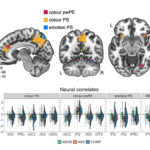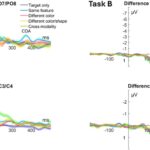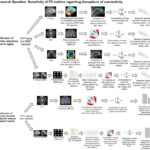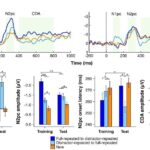Our recent new study, titled “Predictive Processing in ASD: The Aytpical Iterative Prior Updating Account”, published in Biological Psychiatry Global Open Science, challenges long-held assumptions about sensory processing in autism spectrum disorder (ASD). One prominent model “attenuated-prior” model, which claims that individuals with ASD have weakened prior expectations. In our study, we show that while certain experiential priors remain intact—evidenced by accurate one-shot learning and typical performance in gaze direction tasks—there is a distinct overreliance on sensory input during moment-to-moment updates.
Using a duration reproduction task with variable environmental volatility, we applied a two-state Bayesian model (Glasauer & Shi, 2022) to dissect immediate perceptual adjustments (with Kalman gain K1) from slower, iterative prior updates (Kalman gain K2). We found that individuals with ASD exhibit a higher K2 value compared to typically developing controls, suggesting a greater tendency to adjust their priors based on sensory input. This effect was further amplified in high-volatility settings, where all participants showed more pronounced updates.

Figure (A)Two-state iterative Bayesian updating model. The left panels illustrate the iterative updates of the perceptual estimate of the stimulus (State 1), while the right panels depict the iterative updates of the mean of stimulus distribution (State 2). On trial t-1 (top row), the percept (yellow) is computed by multiplying the prior of the stimulus (red) and the sensory likelihood (dark blue). The posterior distribution (light blue) of the stimulus mean is derived by combining the prior of the mean distribution (green) with the sensory likelihood (dark blue). After trial t-1 (middle row), the stimulus mean distribution (light blue) for trial t is updated from the posterior distribution (indicated by the dashed blue arrow). The stimulus prior (red) for trial t is then formulated for the prediction. Additionally, the prediction of the mean of stimulus distribution (green) for trial t is computed from the posterior distribution (light blue). On trial t (bottom row), these processes are repeated as in trial t-1. (B) Estimated Kalman gain K1 for the state of duration prediction; (C) estimated Kalman gain K2 for the updating of the prior belief; (D) general overestimation (ms), separately for two groups (ASD vs. TD) and volatility sessions (Low vs. High). Each group n=32. Error bars denote one standard error.
By differentiating between short-term perceptual adjustments and long-term learning processes, our study highlights a unique interplay between sensory inputs and prior beliefs in ASD, where greater reliance on sensory inputs during prior updating influences adaptation speed and inter-trial dynamics. This process clarifies inconsistencies in the literature and underscores the role of interactive updating in predictive processing differences between ASD and TD individuals.
Reference:
Shi, Z., Allenmark, F., Theisinger, L. A., Pistorius, R. L., Glasauer, S., Müller, H. J., & Falter-Wagner, C. M. (2025). Predictive processing in ASD: The atypical iterative prior updating account. Biological Psychiatry Global Open Science, 100468, 100468. https://doi.org/10.1016/j.bpsgos.2025.100468





